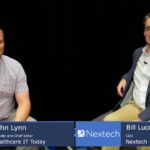The following is a guest article by Alex Long, Head of Life Sciences Sales Strategy at Dell Technologies
In science, avoiding correlation without causation is a cornerstone of research methodology. This fundamental principle ensures that scientific conclusions are grounded in evidence rather than coincidental associations. However, as we venture into the Artificial Intelligence (AI) age, a new challenge emerges – that of “Correlation, not Creation.”
A classic example highlighting the distinction between correlation and causation is the seemingly bizarre connection between ice cream sales and swimming accidents. Both phenomena peak during the summer months, leading one to wonder if indulging in ice cream somehow leads to swimming accidents or vice versa. Of course, any sensible person recognizes that these events are unrelated and that correlation does not imply causation. Ice cream is sold and people typically only swim in the summer – hence the increase in both ice cream sales and swimming accidents during this timeframe. To avoid mistaking correlation for causation, scientists are trained to think critically, seek causative relationships, and not be fooled by superficial correlations.
Generative AI is a remarkable technology that can sift through vast amounts of data and “generate” novel content that often mimics existing patterns. However, despite its impressive capabilities, Generative AI is not immune to the pitfalls of the principle of correlation without causation. It can unwittingly produce outputs that merely correlate with the input data without truly incorporating the underlying principles. This phenomenon is akin to hallucination – the AI creates something, not out of genuine understanding, but through a correlation process.
As a result, human intervention becomes indispensable in scientific research, particularly in healthcare and life sciences, where the consequences of false conclusions can be dire. One recent example is the controversial history of clinical studies related to hormone replacement therapy (HRT). The history of HRT started in the 1960s, with very high popularity in the 1990s. Initial clinical trials concerning HRT’s impact on chronic postmenopausal conditions commenced in the late 1990s, originating in the United States. The release of the inaugural findings from the Women’s Health Initiative (WHI) in 2002, which showed that HRT had more detrimental than beneficial effects, triggered a decline in its utilization. The unfavorable outcomes of the study garnered extensive publicity, instigating alarm among certain users, and generating fresh guidelines for medical practitioners regarding HRT prescriptions. The resulting media message asserted that HRT’s hazards outweighed its advantages for all female individuals.
Subsequent years witnessed a re-analysis of the WHI trial, uncovering that the WHI study was not designed and analyzed correctly and that HRTs do offer cardiovascular benefits to certain segments of the female population after all. This fresh review of the outcomes revealed that the use of HRT in younger or early postmenopausal women had a beneficial effect on the cardiovascular system, reducing the incidence of coronary disease and overall mortality. But the damage was done – and was never fully reversed. Nonetheless, had a group of experts not questioned the initial results, the medical community might never have been aware of the study’s more precise findings, underscoring the importance of human participation.
While AI can crunch numbers at lightning speed and identify complex patterns, it lacks the innate ability to grasp causation’s essence and underlying mechanisms. For example, in computational biology, the correlation vs. causation issue can be found in the study of gene expression and disease association. The scientific method trains researchers to avoid creating conclusions when analyzing gene expression data from different individuals and finding a correlation between the expression levels of a particular gene and the presence of a specific disease. AI will not even know to question that correlation and wouldn’t think to ask about additional confounding variables or if the gene expression might be a consequence of the disease rather than its cause.
Researchers often need to perform functional experiments, genetic manipulations, or use sophisticated statistical methods like Mendelian randomization to establish causation in computational biology. These approaches help uncover whether the gene’s activity directly contributes to the disease or if the correlation was coincidental. It also underscores the importance of the research and their cautious interpretation. AI can significantly accelerate research, but creating a causal understanding requires additional evidence to understand the complex realm of gene expression. In short, researchers must exercise their critical thinking and domain expertise to validate and interpret AI-generated insights.
The way forward lies not in the rejection of AI but in its thoughtful adoption. AI technologies can be used to efficiently extract vital information from vast datasets, expediting the data collection process. However, AI is unable to “create” studies; instead, it empowers researchers to craft accurate analyses. In essence, AI and human intellect can come together to form a symbiotic partnership: AI accelerates data organization, while human minds decipher causation, revealing underlying truths and transforming correlations into meaningful insights.
As we navigate the uncharted waters of the expanding role of AI in scientific decision-making, healthcare and life science leaders must remain vigilant against the potential pitfalls of mistaking correlation for causation. By harnessing AI’s capacity for data analysis and combining it with human domain expertise and critical thinking, we can achieve groundbreaking advancements that shape the future of science. In the age of AI, navigating the nuanced relationship between correlation and causation is central to harnessing the potential of AI technology while upholding the principles of rigorous scientific inquiry.
 About Alex Long
About Alex Long
Alex Long is the Head of Life Sciences Sales Strategy at Dell Technologies. He is a seasoned executive with an impressive background in driving growth and innovation in the life sciences and healthcare sectors. With a wealth of experience in sales strategy, business development, and industry leadership, Alex has consistently delivered outstanding results and spearheaded transformative initiatives. In his current role, Alex is pivotal in delivering new solutions to the life sciences and healthcare verticals. Before his tenure at Dell Technologies, Alex played a significant role in the growth and success of Impinj. As a key stakeholder in the company’s IPO process, Alex provided valuable analysis, reporting, and sales strategy support, further solidifying his life sciences and healthcare expertise.
Dell Technologies is a proud sponsor of Healthcare Scene.













